|
|
|
Sort Order |
|
|
|
Items / Page
|
|
|
|
|
|
|
| Srl | Item |
| 1 |
ID:
094995
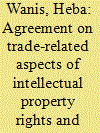

|
|
|
|
|
| Publication |
2010.
|
| Summary/Abstract |
The implementation of the Agreement on Trade-Related Aspects of Intellectual Property Rights (TRIPS Agreement) in Egypt raised concerns over public health implications, resulting from pharmaceutical patents, especially because the Egyptian pharmaceutical industry is heavily dependent on generic production. The current level of global competition in the pharmaceutical market, together with the lack of local pharmaceutical research, threaten the industry, and, as a result, access to affordable medication is expected to be impaired. Determinants of access to medicines are analysed. An epidemiological overview of the most prevalent diseases in Egypt has been done in light of the results of surveys about changes in medicine prices and availability, to speculate about potential limitations in access to medicines. Considering domestic pharmaceutical pricing and marketing regulations, which are mainly concerned with affordability, together with the flexibilities in the TRIPS Agreement, short-term solutions to potential access problems will be possible. Egypt has the necessary theoretical safeguards against negative implications of the TRIPS Agreement on access to treatment. However, this does not necessarily mean that these safeguards will be implemented in a way that will protect against the implications of patent protection on medicines in the long term.
|
|
|
|
|
|
|
|
|
|
|
|
|
|
|
|
| 2 |
ID:
105132


|
|
|
|
|
| Publication |
2011.
|
| Summary/Abstract |
Agricultural machinery involves use of equipment and machines that are required to perform various crop production activities. The use of agricultural machinery leads to better utilization of inputs and improvement in agricultural operations, particularly in large scale crop production. Most of the earlier innovations in India in this sector were on tractors and drillers. There has been an increase in the innovations in machinery in the pre-harvest as well as post-harvest operations. The present study attempts to analyse patenting activity to identify current innovations on agricultural machinery in India. Analysis of published applications revealed that the area of irrigation and post-harvest processing had the maximum filing. In the case of granted patents, majority of the patents belong to the area of plant growth and post-harvest operations. The analysis reveals the specific patent portfolios and the scope of future innovations in the agriculture engineering sector.
|
|
|
|
|
|
|
|
|
|
|
|
|
|
|
|
| 3 |
ID:
078885
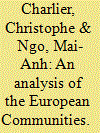

|
|
|
|
|
| Publication |
2007.
|
| Summary/Abstract |
The dispute European Communities-Protection of trademarks and geographical indications for agricultural products and foodstuffs, which opposes the European Union with the United States and Australia, has been raised by the European regulation concerning the protection of geographical indications (GIs). This dispute has two important issues. First, the Panel has demonstrated that the European Regulation does not comply with national treatment promulgated by the Agreement on Trade-Related Aspects of Intellectual Property Rights and the General Agreement on Tariffs and Trade 1994. Second, the Panel affirmed the possibility of some coexistence between GIs and identical prior trademarks. This article considers these issues and describes the positions of the parties at the end of the dispute over protection of GIs. The first part discusses the Panel's conclusions on national treatment and the coexistence of GIs and prior trademarks. The second part provides an analysis of the relationship between national treatment and international harmonization of the rules on the protection of GIs. This shows that if the Panel findings do not annihilate the European system of protection of GIs, the United States will find it advantageous to free ride and resist any move towards the European system of protection.
|
|
|
|
|
|
|
|
|
|
|
|
|
|
|
|
| 4 |
ID:
110492


|
|
|
| 5 |
ID:
089872


|
|
|
| 6 |
ID:
072282


|
|
|
|
|
| Publication |
2006.
|
| Summary/Abstract |
In the modern global economy, transnational corporations have become important sources of technology, market access and capital - all of which states seek in propelling economic growth. States themselves provide territory, and establish the 'rules of the game' by which corporations may operate within that territory. However, with the commodification and commercialisation of indigenous cultural and intellectual property, states are bypassed and negotiations emerge between corporations and sub-state actors who claim to represent population segments. May the bypassing of the state further weaken national or state identity among indigenous groups? Such is the case that may be emerging in Africa with groups who claim profits derived from the development and marketing of indigenous cultural and intellectual property. This paper explores the possibility that profit-sharing agreements between transnational corporations and sub-state groups may contribute to the widening of ethnic cleavages in African states by promoting inequalities between groups.
|
|
|
|
|
|
|
|
|
|
|
|
|
|
|
|
| 7 |
ID:
101072
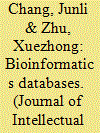

|
|
|
|
|
| Publication |
2010.
|
| Summary/Abstract |
Intellectual property (IP) protection for bioinformatics databases plays a key role in accelerating development of biological sciences and biotechnological industry. This paper presents current and global position of IP protection in bioinformatics database. A protection method has been proposed after analysing characteristics of bioinformatics databases and considering different database protection methods. Further, the paper seeks to analyse the diffusion process of biological information and develops an argument that bioinformatics primary database should be put in public domain, though they may be given financial subsidies by the government or other public funds according to the diffusion phase of biological information. Suitable methods of IP protection in the bioinformatics secondary database have been suggested.
|
|
|
|
|
|
|
|
|
|
|
|
|
|
|
|
| 8 |
ID:
105137
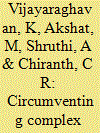

|
|
|
|
|
| Publication |
2011.
|
| Summary/Abstract |
Licensing of technologies by companies and research institutes is a recent phenomenon that has gained immense popularity in the agricultural sector, it being imperative for the research fraternity to gain access to validated technologies, enhance their product portfolio, and accelerate access to commercialization ensuring outreach of good science to farmers. Two case studies pertaining to rice and chickpea are discussed in the paper to elucidate this process.
|
|
|
|
|
|
|
|
|
|
|
|
|
|
|
|
| 9 |
ID:
125439
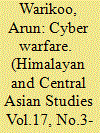

|
|
|
|
|
| Publication |
2013.
|
| Summary/Abstract |
The 21st century is rightly dubbed as an information age. Endless information is readily available made possible by interconnection of billions of computers systems globally over a backbone of networks commonly referred to as the internet the growing reliance on laptops, computer systems, ipads and smart phone to perform most of our tasks has created a parallel world the cyber world.
|
|
|
|
|
|
|
|
|
|
|
|
|
|
|
|
| 10 |
ID:
099815
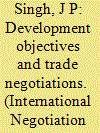

|
|
|
|
|
| Publication |
2010.
|
| Summary/Abstract |
To what extent do trade negotiations deliver on development objectives articulated from the developing world? In the past, the developed world deployed moralistic foreign policies and largesse to placate the developing world. The article examines the ways in which the global power configurations are now changing to allow developing countries to gain concessions instead through negotiations that are consistent with their development aspirations. It first provides a brief negotiation history of the developing world's relationship with the General Agreement on Tariffs and Trade (GATT) through the lens of development. The article then analyzes the intellectual property and agricultural negotiations at the current Doha Round of the World Trade Organization (WTO) to conclude that the developed world's preferred outcome remains moral largesse rather than making trade concessions.
|
|
|
|
|
|
|
|
|
|
|
|
|
|
|
|
| 11 |
ID:
117956
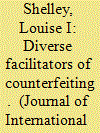

|
|
|
|
|
| Publication |
2012.
|
| Summary/Abstract |
Counterfeits may be the least policed form of transnational crime, although the profits from their sale total in the billions of dollars annually. The counterfeits traded by transnational criminals can be subdivided into two categories: those that merely represent copyright infringement and those that cause harm to life and society. In the first category are such counterfeits as clothing, purses, other consumer goods, and DVDs and other forms of intellectual property. In the second category are counterfeit pharmaceuticals, food, wine, cigarettes, and spare parts. Both forms of counterfeit, however, can be exploited by terrorists because of the low risk and high profits associated with this commerce that makes this trade more dangerous. The article will focus on the actors associated with this illicit trade, as well as the supply, the demand, and the limited law enforcement response. Particular focus will be paid to the counterfeits that cause harm to human life.
|
|
|
|
|
|
|
|
|
|
|
|
|
|
|
|
| 12 |
ID:
110287


|
|
|
|
|
| Publication |
2011.
|
| Summary/Abstract |
Worldwide filing of patent applications and the ensuing invalidation requests have seen staggering growth over the last decade. The result is increasing patent backlog, deteriorating patent quality and an uncertain economic environment. Patent application review is an integral part of the examination procedures undertaken by patent offices before a patent grant is given. Prior art search is a complex and time consuming part of this process. Crowdsourcing this critical stage is a valuable opportunity to render the patent application review process more efficient. This paper describes the crowdsourcing phenomenon and details how it can aid patent review. The open source review pilot projects of the USPTO and JPO are presented in order to assess the potential of opening prior art search to the wider community of experts and practitioners. Public-private partnerships between patent offices and companies managing online review communities are proposed as a valuable opportunity to leverage the benefits of open review while providing sufficient incentives and quality assurances to yield useful contributions.
|
|
|
|
|
|
|
|
|
|
|
|
|
|
|
|
| 13 |
ID:
165348


|
|
|
|
|
| Summary/Abstract |
We explore the efficacy of counterespionage measures in the realm of Economic Espionage. Although it is possible that increasing counterespionage measures has the desired effect of increasing domestic research and development (R&D) and reducing espionage by foreign entities, it is also possible that these increased measures actually do just the opposite: domestic R&D suffers and foreign stealing increases. We identify the appropriate settings for increased counterespionage measures and provide some policy advice.
|
|
|
|
|
|
|
|
|
|
|
|
|
|
|
|
| 14 |
ID:
085863


|
|
|
|
|
| Publication |
2008.
|
| Summary/Abstract |
The Agreement on Trade-Related Aspects of Intellectual Property Rights is the most important as well as the most controversial instrument to date concerning intellectual property protection. What is not clear is the impact it will have on developing countries and whether it will actually meet its objective in the "… promotion of technological innovation and to the transfer and dissemination of technology …". The proponents of a strong patent regime vehemently argue that strengthening patent protection will lead to greater technology transfer in developing countries, and consequently inflow of foreign direct investment (FDI) as it is the most important channel for technology transfer. This article takes the Indian pharmaceutical industry as an example to examine the above assertion, and argues that simply enhancing patent protection may not necessarily result in a corresponding increase in FDI in the Indian pharmaceutical sector. It shows that in addition to strong patent protection, there are equally or even more important factors that have a bearing on the inflow of FDI.
|
|
|
|
|
|
|
|
|
|
|
|
|
|
|
|
| 15 |
ID:
123436
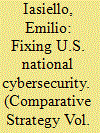

|
|
|
|
|
| Publication |
2013.
|
| Summary/Abstract |
In 2011, the White House and the Department of Defense released strategies for how the United States will approach cyberspace both from an offensive and defensive perspective. Cybersecurity has long been America's Achilles' heel where public and private networks are consistently exploited by criminals, hacktivists, and espionage actors stealing financial data, intellectual property, and sensitive information. The U.S. government has failed to instill an effective national-level cybersecurity apparatus. In order to better position itself defensively, the U.S. government needs to reposition its federal agencies to better capitalize on their capabilities and authorities to address this twenty-first century threat.
|
|
|
|
|
|
|
|
|
|
|
|
|
|
|
|
| 16 |
ID:
117969
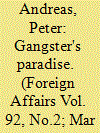

|
|
|
|
|
| Publication |
2013.
|
| Summary/Abstract |
The dark underside of the global economy is thriving. Globalization has been good not only for legitimate businesses but also for those who traffic in illegal drugs, evade sanctions or taxes, trade stolen goods and intellectual property on the black market, smuggle immigrants, and launder money. Some of these activities are merely policing headaches. But others pose major security challenges to governments around the world.
|
|
|
|
|
|
|
|
|
|
|
|
|
|
|
|
| 17 |
ID:
046214


|
|
|
|
|
| Publication |
Hampshire, Palgrave Macmillan, 2002.
|
| Description |
xiv, 281p.
|
| Standard Number |
0333996277
|
|
|
|
|
|
|
|
|
|
|
|
Copies: C:1/I:0,R:0,Q:0
Circulation
| Accession# | Call# | Current Location | Status | Policy | Location |
| 046119 | 341.759/DRA 046119 | Main | On Shelf | General | |
|
|
|
|
| 18 |
ID:
128912


|
|
|
| 19 |
ID:
180838


|
|
|
|
|
| Summary/Abstract |
Global justice theorists have widely discussed how the international intellectual property rights regime (i.e., the TRIPs regime of the World Trade Organization) makes it more difficult to achieve the goal of universal access to generic (and more affordable) vital COVID-19 treatments (including potential COVID-19 vaccines). This article argues that while patents can impose certain barriers to universal access to generic COVID-19 treatments, the TRIPs regime itself is an integral part of an equitable global solution to the pandemic. More specifically, it argues that article 31bis of the TRIPs, in allowing for a cooperation strategy predicated on complementary importing and exporting of vital COVID-19 generic treatments, is key for successful pandemic suppression. By providing a normative interpretative analysis of article 31bis in light of the ethical requirements of global justice, and by responding to possible objections to its core argument, this article substantiates the ideal of multilateral solidarity among nations. In times of crisis—not only a crisis of global public health, but also a crisis of multilateralism—this complementary cooperation strategy that article 31bis allows for shows a way forward in upholding the global common good that the international legal order seeks to safeguard.
|
|
|
|
|
|
|
|
|
|
|
|
|
|
|
|
| 20 |
ID:
121774


|
|
|
|
|
| Publication |
2013.
|
| Summary/Abstract |
This paper analyses the impact of intellectual property laws on food security in Least Developed Countries (LDCs), taking the Pacific Islands countries as an example. It argues that ip laws are increasingly impacting upon food security, but are not being adequately taken into account in national policy development. Consequently, national ip regimes are developing in ways that undermine, rather than promote, food security. The paper argues that the particular context of LDCs, including a lack of technological development and reliance upon traditional agricultural systems, requires an approach to intellectual property that is substantially different from the 'one size fits all' approach mandated by the Agreement on Trade-Related Aspects of Intellectual Property Rights.
|
|
|
|
|
|
|
|
|
|
|
|
|
|
|
|
|
|
|
|
|